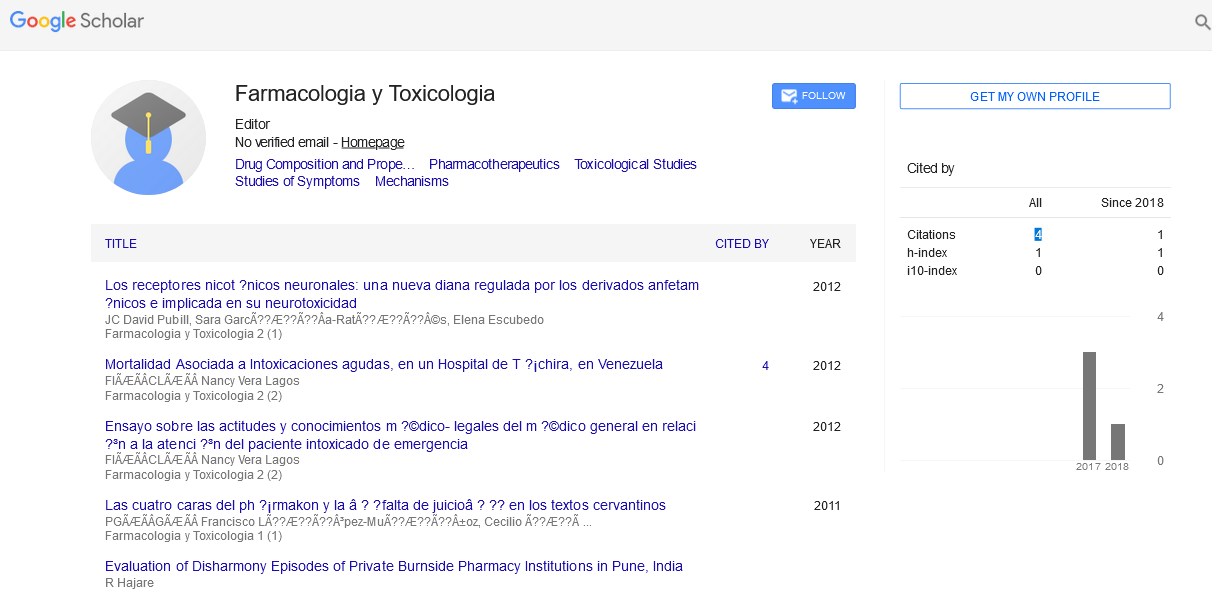Perspective - (2024) Volume 14, Issue 4
Acute Toxicology: Risks and Impact on Human Health
Ryan Belowitz*
Department of Toxicology, University of Jalto, Helsinki, Finland
*Correspondence:
Ryan Belowitz, Department of Toxicology, University of Jalto, Helsinki,
Finland,
Email:
Received: 02-Jul-2024, Manuscript No. IPFT-24-14969;
Editor assigned: 05-Jul-2024, Pre QC No. IPFT-24-14969 (PQ);
Reviewed: 19-Jul-2024, QC No. IPFT-24-14969;
Revised: 01-Aug-2024, Manuscript No. IPFT-24-14969 (R);
Published:
29-Aug-2024
Introduction
Toxicology, the study of harmful effects of chemicals and
substances on living organisms, encompasses various facets
crucial for safeguarding public health. Among these, acute
toxicology plays a pivotal role in assessing the immediate effects
of exposure to potentially harmful substances. This field not only
informs emergency medical responses but also guides regulatory
decisions aimed at minimizing risks to human health.
Description
Acute toxicology
Acute toxicology focuses on the adverse effects that occur
shortly after a single exposure to a substance. This discipline is
critical in determining the toxicity of chemicals, drugs, pesticides
and other substances, providing vital data for hazard assessment
and safety regulations. The severity of acute toxicity varies
widely depending on factors such as the dose, route of exposure
and individual susceptibility.
Principles of acute toxicity assessment
The assessment of acute toxicity involves several key
principles:
Dose-response relationship: Understanding how the severity
of toxic effects correlates with the dose administered.
Routes of exposure: Different routes, such as ingestion,
inhalation, dermal contact or injection, can lead to varying levels
of toxicity.
Lethal Dose (LD50): The dose at which 50% of the exposed
population would be expected to die. This metric helps
determine the substance's toxicity level.
Methods and testing procedures
Acute toxicity testing typically involves laboratory
experiments using animals like rats, mice or rabbits. These tests
aim to identify the substance's effects at various doses and
routes of exposure. However, ethical concerns and
advancements in alternative methods, such as in vitro assays
and computer models, are pushing for reduced animal use
where possible.
Toxicity testing
Toxicology, the study of harmful effects of chemicals and
substances on living organisms, encompasses various facets
crucial for safeguarding public health. Among these, acute
toxicology plays a pivotal role in assessing the immediate effects
of exposure to potentially harmful substances. This field not only
informs emergency medical responses but also guides regulatory
decisions aimed at minimizing risks to human health.
LD50 (Lethal Dose 50): This test determines the dose of a
substance that is lethal to 50% of the test population. It helps
establish the acute toxicity level and guides safety regulations.
Observational studies: These involve monitoring animals for
behavioral changes, physiological responses and mortality rates
following exposure to the substance under investigation.
In vitro testing
Advancements in technology have led to the development of in vitro methods that reduce reliance on animal testing. These
techniques use isolated cells or tissues to simulate the effects of
substances on biological systems. In vitro testing provides
valuable data on cellular responses, metabolism and potential
mechanisms of toxicity without the ethical concerns associated
with animal testing.
Computational modeling
Computational toxicology integrates mathematical models,
databases and computer simulations to predict toxicity
outcomes based on chemical structure, molecular interactions
and biological pathways. This approach accelerates toxicity
assessments, identifies potential hazards early in product
development and supports risk management strategies.
Regulatory implications
Regulatory bodies worldwide rely on acute toxicity data to
establish safe exposure limits, label requirements, and
emergency response protocols. For example, the Globally
Harmonized System (GHS) for Classification and Labelling of
Chemicals provides standardized criteria for classifying
substances based on their acute toxicity.
Common substances and their effects
Heavy metals: Lead, mercury and cadmium can cause severe
acute toxicity through ingestion or inhalation, affecting the
nervous system, kidneys and other organs.
Pesticides: Herbicides, insecticides and fungicides pose acute
health risks to agricultural workers and consumers if improperly
handled or applied.
Pharmaceuticals: Overdoses or adverse reactions to
medications can lead to acute toxicity, manifesting in symptoms
ranging from nausea to respiratory failure.
Case studies and real-world impacts
Historical incidents underscore the importance of acute
toxicity awareness:
Bhopal disaster (1984): Methyl isocyanate gas leak in India
resulted in thousands of deaths and highlighted the need for
stringent chemical safety measures.
Fukushima daiichi nuclear disaster (2011): Acute radiation
exposure led to immediate health risks among workers and
nearby residents, necessitating prompt medical interventions.
Challenges and future directions
Despite advancements, acute toxicity assessment faces
challenges:
Data variability: Variations in individual responses and
environmental factors complicate accurate toxicity predictions.
Ethical concerns: Pressure to reduce animal testing while
ensuring reliable safety assessments remains a significant ethical
and scientific challenge.
Emerging substances: Novel chemicals and products pose
unforeseen acute toxicity risks, necessitating continuous
vigilance and adaptive regulatory frameworks.
Conclusion
Acute toxicology serves as a cornerstone in safeguarding
public health by providing essential insights into the immediate
risks posed by various substances. Through robust testing
methodologies and regulatory oversight, it helps mitigate the
adverse impacts of chemical exposures on human health and
the environment. Continued research and collaboration across
disciplines will be crucial in addressing evolving challenges and
ensuring safer living and working environments globally. As we
navigate future challenges, collaboration between scientists,
regulators and industry stakeholders remains essential to
advancing our understanding and application of acute toxicology
in ensuring a safer and healthier world.
Citation: Belowitz R (2024) Acute Toxicology: Risks and Impact on Human Health. Farmacologia Toxicologia, Vol.14 No.4: 032





